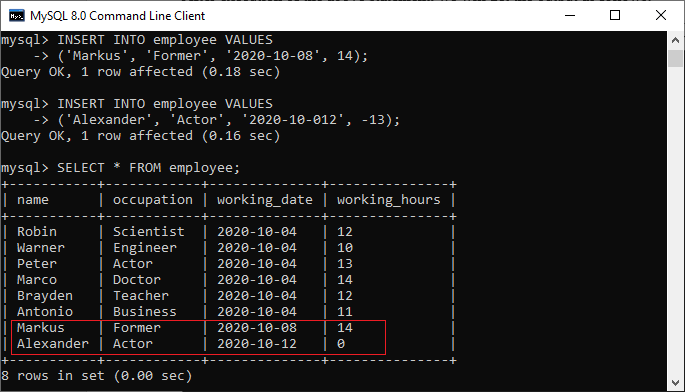-
MySQL Tutorial
- mysql-tutorial
- mysql-features
- mysql-versions
- mysql-data-types
- mysql-variables
- install-mysql
- mysql-connection
MySQL Workbench
User Management
MySQL Database
- mysql-create-database
- mysql-select-database
- mysql-show-databases
- mysql-drop-database
- mysql-copy-database
Table & Views
- mysql-create-table
- mysql-alter-table
- mysql-show-tables
- mysql-rename-table
- mysql-truncate-table
- mysql-describe-table
- mysql-drop-table
- mysql-temporary-table
- mysql-copy-table
- mysql-repair-table
- mysql-add/delete-column
- mysql-show-columns
- mysql-rename-column
- mysql-views
- mysql-table-locking
- mysql-account-lock
MySQL Queries
- mysql-select-record
- mysql-replace
- insert-on-duplicate-key-update
- mysql-insert-ignore
- insert-into-select
MySQL Indexes
- mysql-create-index
- mysql-drop-index
- mysql-show-indexes
- mysql-unique-index
- mysql-clustered-index
- mysql-clustered-vs-non-clustered-index
MySQL Clauses
MySQL Privileges
Control Flow Function
MySQL Conditions
- mysql-and
- mysql-or
- mysql-and-or
- mysql-boolean
- mysql-like
- mysql-in
- mysql-any
- mysql-exists
- mysql-not
- mysql-not-equal
- mysql-is-null
- mysql-is-not-null
- mysql-between
MySQL Join
- mysql-join
- mysql-inner-join
- mysql-left-join
- mysql-right-join
- mysql-cross-join
- mysql-self-join
- mysql-delete-join
- mysql-update-join
- mysql-equijoin
- mysql-natural-join
- left-join-vs-right-join
- mysql-union-vs-join
MySQL Key
MySQL Triggers
- mysql-trigger
- mysql-create-trigger
- mysql-show-trigger
- mysql-drop-trigger
- before-insert-trigger
- after-insert-trigger
- mysql-before-update-trigger
- mysql-after-update-trigger
- mysql-before-delete-trigger
- mysql-after-delete-trigger
Aggregate Functions
- mysql-aggregate-functions
- mysql-count()
- mysql-sum()
- mysql-avg()
- mysql-min()
- mysql-max()
- mysql-group_concat()
- mysql-first()
- mysql-last()
MySQL Misc
- mysql-comments
- export-import-database
- import-csv-file-in-database
- export-table-to-csv
- mysql-subquery
- mysql-derived-table
- mysql-uuid
- lead-and-lag-function
- mysql-cte
- mysql-on-delete-cascade
- mysql-upsert
- mysql-commands-cheat-sheet
- mysql-transaction
- mysql-partitioning
- mysql-row_number()
- mysql-cursor
- mysql-limit
- mysql-stored-function
- mysql-signal-resignal
- number-format-function
- mysql-ranking-functions
- mysql-window-functions
- mysql-union
- union-vs-union-all
- mysql-varchar
- mysql-enum
- mysql-set
- mysql-decimal
- mysql-cast
- mysql-convert()
- mysql-coalesce()
- mysql-wildcards
- mysql-alias
- mysql-functions
- mysql-rollup
- mysql-int
- mysql-today
- mysql-row-count
- prepared-statement
- mysql-literals(constants)
- mysql-date-time
- mysql-procedure
- mysql-minus
- mysql-intersect
- mysql-storage-engines
- mysql-explain
- mysql-sequence
- mysql-json
- mysql-standard-deviation
- how-to-select-nth-highest-record
- find-duplicate-records
- delete-duplicate-records
- mysql-select-random-records
- mysql-extract
- mysql-processlist
- mysql-bit
- change-column-type
- mysql-reset-auto-increment
- mysql-interval
- login-with-different-user
MySQL Globalisation
Regular Expressions
- regular-expressions
- mysql-rlike
- not-like-operator
- not-regexp-operator
- regexp-operator
- regexp_instr()-function
- regexp_like()-function
- regexp_replace()-function
- regexp_substr()-function
FULLTEXT Search
- mysql-fulltext-search
- natural-language-fulltext-search
- boolean-fulltext-search
- query-expansion-fulltext-search
- ngram-fulltext-parser
Differences
- mysql-vs-mongodb
- mysql-vs-ms-sql-server
- mysql-vs-oracle
- mariadb-vs-mysql
- postgresql-vs-mysql
- mysql-vs-sql
- table-vs-view
- delete-vs-truncate-command
- database-vs-schema
- primary-key-vs-foreign-key
- primary-key-vs-unique-key
- primary-key-vs-candidate-key
Interview Questions
MySQL Create TriggerIn this article, we are going to learn how to create the first trigger in MySQL. We can create a new trigger in MySQL by using the CREATE TRIGGER statement. It is to ensure that we have trigger privileges while using the CREATE TRIGGER command. The following is the basic syntax to create a trigger: Parameter ExplanationThe create trigger syntax contains the following parameters: trigger_name: It is the name of the trigger that we want to create. It must be written after the CREATE TRIGGER statement. It is to make sure that the trigger name should be unique within the schema. trigger_time: It is the trigger action time, which should be either BEFORE or AFTER. It is the required parameter while defining a trigger. It indicates that the trigger will be invoked before or after each row modification occurs on the table. trigger_event: It is the type of operation name that activates the trigger. It can be either INSERT, UPDATE, or DELETE operation. The trigger can invoke only one event at one time. If we want to define a trigger which is invoked by multiple events, it is required to define multiple triggers, and one for each event. table_name: It is the name of the table to which the trigger is associated. It must be written after the ON keyword. If we did not specify the table name, a trigger would not exist. BEGIN END Block: Finally, we will specify the statement for execution when the trigger is activated. If we want to execute multiple statements, we will use the BEGIN END block that contains a set of queries to define the logic for the trigger. The trigger body can access the column's values, which are affected by the DML statement. The NEW and OLD modifiers are used to distinguish the column values BEFORE and AFTER the execution of the DML statement. We can use the column name with NEW and OLD modifiers as OLD.col_name and NEW.col_name. The OLD.column_name indicates the column of an existing row before the updation or deletion occurs. NEW.col_name indicates the column of a new row that will be inserted or an existing row after it is updated. For example, suppose we want to update the column name message_info using the trigger. In the trigger body, we can access the column value before the update as OLD.message_info and the new value NEW.message_info. We can understand the availability of OLD and NEW modifiers with the below table:
MySQL Trigger ExampleLet us start creating a trigger in MySQL that makes modifications in the employee table. First, we will create a new table named employee by executing the below statement: Next, execute the below statement to fill the records into the employee table: Next, execute the SELECT statement to verify the inserted record:  Next, we will create a BEFORE INSERT trigger. This trigger is invoked automatically insert the working_hours = 0 if someone tries to insert working_hours < 0. If the trigger is created successfully, we will get the output as follows:  Now, we can use the following statements to invoke this trigger: After execution of the above statement, we will get the output as follows:  In this output, we can see that on inserting the negative values into the working_hours column of the table will automatically fill the zero value by a trigger. Next TopicMySQL Show/List Triggers
|